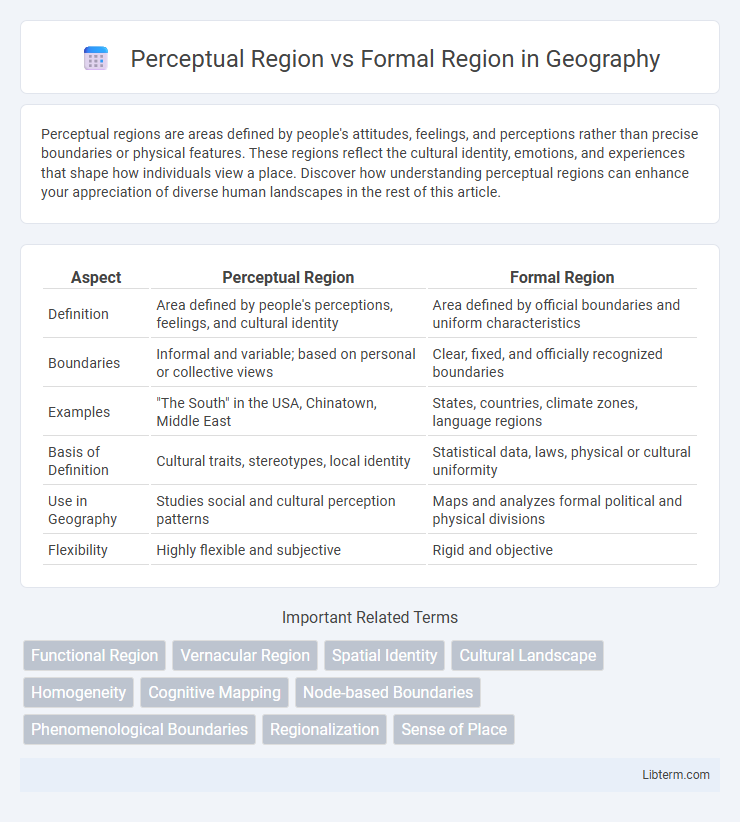Perceptual regions are areas defined by people's attitudes, feelings, and perceptions rather than precise boundaries or physical features. These regions reflect the cultural identity, emotions, and experiences that shape how individuals view a place. Discover how understanding perceptual regions can enhance your appreciation of diverse human landscapes in the rest of this article.
Table of Comparison
| Aspect | Perceptual Region | Formal Region |
|---|---|---|
| Definition | Area defined by people's perceptions, feelings, and cultural identity | Area defined by official boundaries and uniform characteristics |
| Boundaries | Informal and variable; based on personal or collective views | Clear, fixed, and officially recognized boundaries |
| Examples | "The South" in the USA, Chinatown, Middle East | States, countries, climate zones, language regions |
| Basis of Definition | Cultural traits, stereotypes, local identity | Statistical data, laws, physical or cultural uniformity |
| Use in Geography | Studies social and cultural perception patterns | Maps and analyzes formal political and physical divisions |
| Flexibility | Highly flexible and subjective | Rigid and objective |
Introduction to Geographic Regions
Perceptual regions are defined by people's feelings, beliefs, and cultural identity, reflecting subjective impressions rather than strict boundaries. Formal regions are characterized by clearly defined and measurable criteria such as administrative borders, climate zones, or language groups, providing objective geographic categorization. Understanding these geographic regions highlights how spatial areas are conceptualized differently based on human perception versus empirical data.
Defining Perceptual Regions
Perceptual regions are defined by shared feelings, attitudes, and cultural identity perceived by people rather than by strict boundaries, often reflecting subjective views of areas such as "The South" in the United States. These regions contrast with formal regions, which are characterized by clearly defined governmental or administrative borders and consistent physical or cultural traits, like countries or states. Understanding perceptual regions helps in analyzing human geography through social constructs and regional identity rather than legal demarcations.
Key Characteristics of Perceptual Regions
Perceptual regions are defined by human feelings, attitudes, and cultural identity rather than strict boundaries, making their key characteristics subjective and fluid. Unlike formal regions with clear, measurable borders and uniform traits, perceptual regions rely on shared perceptions and emotional connections within a population. Examples include the American South or Silicon Valley, where social constructs and recognizable cultural features shape the region's identity.
What Is a Formal Region?
A formal region, also known as a uniform or homogeneous region, is defined by consistent and measurable criteria such as language, climate, political boundaries, or economic activity. It is characterized by clear, official boundaries that are recognized by governments or organizations, making it quantifiable and distinct from other areas. Examples include countries, states, or cities where specific laws and regulations apply uniformly across the entire area.
Main Features of Formal Regions
Formal regions are defined by uniformity in one or more physical or cultural characteristics, such as language, climate, or political boundaries. These regions have clearly established borders recognized by governmental or administrative bodies, making them statistically measurable and consistent. Examples include countries, states, and cities where demographic data is systematically collected and regulated.
Perceptual Region vs Formal Region: Core Differences
Perceptual regions are defined by people's feelings, attitudes, and perceptions, often varying between individuals, whereas formal regions are clearly delineated areas with official boundaries recognized by government or administrative bodies. Perceptual regions tend to be fluid and culturally subjective, reflecting social constructs like "the South" or "the Midwest," while formal regions rely on quantifiable data such as political borders, climate zones, or language distribution. The core difference lies in perceptual regions being mental maps influenced by human experience versus formal regions grounded in objective criteria and consistent, verifiable definitions.
Real-World Examples of Perceptual Regions
Perceptual regions are defined by people's shared feelings and attitudes toward a place, exemplified by the American South, known for its distinctive culture, cuisine, and dialect, or Silicon Valley, recognized globally as a tech innovation hub. Unlike formal regions with officially recognized boundaries, perceptual regions are subjective and influenced by social or cultural identities. These regions often shape tourism, marketing strategies, and regional identities based on collective perception rather than strict geographic demarcations.
Practical Applications of Formal Regions
Formal regions, defined by consistent physical or cultural traits such as climate zones, political boundaries, or language areas, support practical applications in urban planning, resource management, and policy-making by providing clear, measurable criteria for decision-making. Their precise boundaries enable effective allocation of resources, implementation of laws, and statistical analysis in geographic information systems (GIS). This contrasts with perceptual regions, which are based on subjective cultural perceptions and often lack defined borders, limiting their utility in structured administrative or scientific contexts.
Importance in Geography and Spatial Analysis
Perceptual regions shape human behavior and cultural identity by reflecting how people perceive and organize space based on shared feelings and experiences, making them crucial for understanding social dynamics and place attachment in geography. Formal regions, defined by uniform physical or cultural traits such as climate zones or language areas, provide objective criteria essential for mapping, statistical analysis, and policy-making in spatial studies. The distinction between perceptual and formal regions enables geographers to analyze space from both subjective and empirical perspectives, enhancing comprehensive spatial analysis and regional planning.
Conclusion: Understanding Regional Concepts
Perceptual regions are defined by human feelings and attitudes, reflecting cultural identity and subjective perception, while formal regions are characterized by clearly defined boundaries and uniform physical or administrative features. Understanding these regional concepts enhances geographic analysis by distinguishing between objective data-driven areas and those shaped by social constructs. This differentiation is crucial for accurate spatial planning, policy-making, and interpreting human-environment interactions.
Perceptual Region Infographic

 libterm.com
libterm.com